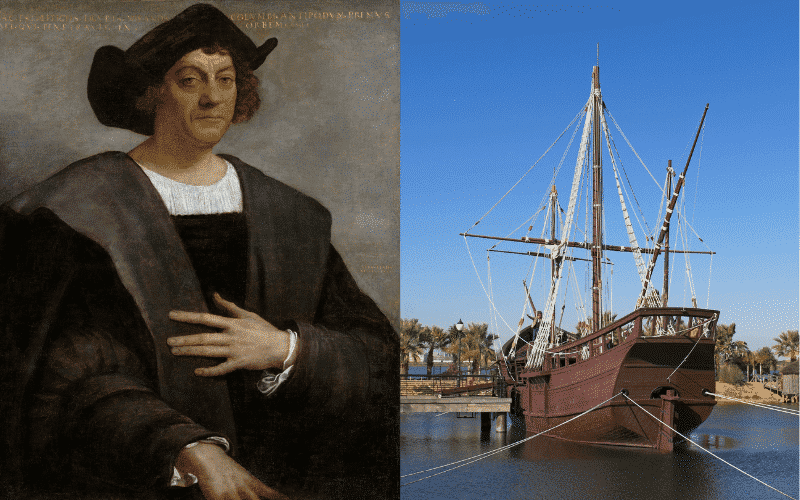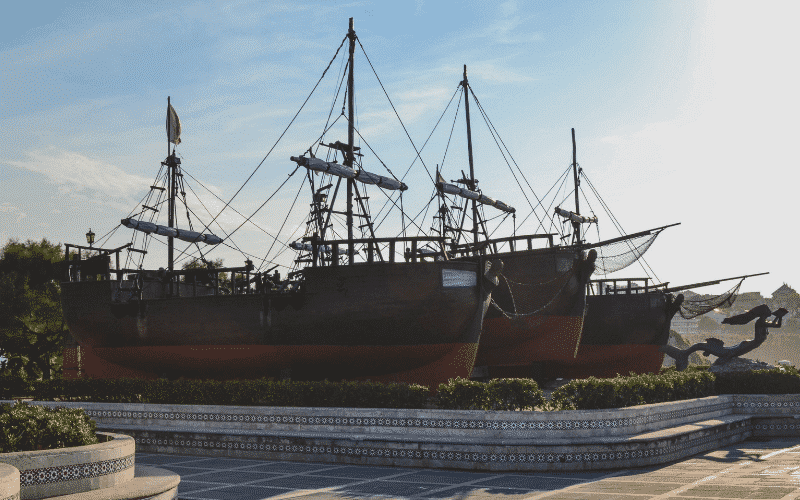Christopher Columbus Ships: Vessels that Discovered America
Christopher Columbus might have discovered America, but Christopher Columbus’ ships are the ones that deserve immediate recognition. However, despite decades of dedicated searching by archaeologists, the three ships used on his first expedition are still undiscovered.
In an era where ships were the only fastest mode of transport to travel across the world, Christopher Columbus’s Ships revolutionised the entire concept of ship travel. They are remembered in the popular culture of America, and generations of school children have grown up learning about them.
In the 15th century, when Christopher Columbus sailed from Spain, he had the critical support of three ships, now famously known as the Christopher Columbus Ships, and his ships’ crewmen.
With such support, Christopher Columbus finally managed to discover America and put the existence of a powerful nation on the map of the world.
Colombus began his voyage on 3rd August 1492 from Palos de la Frontera, Spain, with a fleet of three ships. After he discovered the Americas, the Spanish Crown gave him 17 ships for colonising Hispaniola.
Christopher Columbus Ships
Santa Maria, Niña and the Pinta were the three Ships that have gained immense popularity and recognition in modern times, not just because they helped Christopher Columbus find out about an entire nation but also because they gave water transport a new sense of achievement and purpose, especially today when water transport is not as popular as it was earlier.
Interestingly, at least two of these were nicknames given by crew to their ships and drew heavily from the vernacular. Their original names were La Santa Clara, La Pinta and La Santa Gallega. The ship nicknames were not liked by the church as they were based on the names of the prostitutes. However, they tell us about the other series of events that unfolded in those times.
Of the three Ships, Santa Maria was the adventurer’s flagship. To put it in non-marine terms, a flagship is like a leader. Therefore, out of the three Ships, Santa Maria was the leader.
A cargo ship weighing around 200-600 tons and measuring about 18 meters in length, 12 meters keel lengthwise, six meters beam-wise, and two meters draft-wise, the Santa Maria had a crew of about 52 members.
The original name of Santa Maria was La Gallega, after Galicia, where the ship was built. Still, Christopher Columbus changed the ship’s name to Santa Maria de la Immaculate Concepción or just Santa Maria.
Santa Maria had three main masts, each with sails. These masts were known as the mainmast, the foremast and the mizzenmast. And while this ship had positive attributes, the main negative feature was that its building did not allow Santa Maria to sail near the shallow waters and the coral reefs, thus providing a ship with a handicap.
According to Colombus’s logbook, Santa Maria ran aground on a reef off Cap Haïtien, Haiti, on Christmas Eve, 1492. Its hull was used for building the fortified village of La Navidad, which has not been found yet. Many archaeologists are looking for the vessel in Anne’s Bay and other regions.
However, the other two ships, Niña and Pinta, solved the disadvantage that the flagship of the Christopher Columbus Ships provided and helped him complete his adventure successfully. Niña, in Spanish, means a girl and Pinta refer to the excessive paint job done to the third of the Christopher Columbus ships.
Niña and Pinta were caravel ships. Caravel ships were designed just to beat the disadvantage of sailing in the shallow waters and coral reefs that ships like Santa Maria encountered and were lightweight and easy to manoeuvre around. They could explore the coastlines of modern-day Cuba or sail close to the coast of the canary islands. Portuguese caravels also had triangular sails, hung at a 45-degree angle to the deck.
Around 18 crew members formed the Niña and the Pinta shipping entourage. Of all the three Christopher Columbus Ships, the Pinta was the fastest, reaching a maximum top speed of about 8 knots a day (around 200 miles), while Santa Maria was the slowest, owing to its larger size. Pinta’s captain was Martín Alonso Pinzón, a resident of Andalucia.
Size-wise, the Niña weighed around 50 -60 tons and measured about 15 meters lengthwise, 12 meters keel lengthwise, five meters beam-wise, and two meters depth-wise. It was captained by Vicente. Añes Pinzón, brother of Martín.
The Pinta, on the other hand, weighed around 70 tons and measured about 17 meters lengthwise, 13 meters keel lengthwise, five meters beam-wise, and two meters depth-wise.
The Niña and the Pinta were offered as levies by the Royal Crown of Spain to Christopher Columbus because of a rule which spoke about asking for the levy as punishment if and when the citizens had done a wrong deed against the Spanish Royalty.
Furthermore, four of the crew members on the Christopher Columbus Ships were criminals who were offered amnesty instead of volunteering to be a part of the voyage by the Spanish Crown.
Thus, with the help of the Spanish Royalty and Christopher Columbus, the three Christopher Columbus Ships pioneered their way into the oceanic waters, cruised and discovered a huge country in the West.
In today’s times, when air travel has become the norm and reaching out to the moon has become an ordinary achievement, the successful adventure of Christopher Columbus and Christopher Columbus Ships is a piece of history that any person anywhere in the world will want to know and be eager about.
Frequently Asked Questions
1. What type of ships did Columbus use?
Colombus had not found a western route to India. Still, he crossed the Atlantic due to the ships he chose for this dangerous journey, especially the Pinta and Nina, which were special kinds of speedy ships called caravels.
2. How many ships did Columbus have?
Colombus started his voyage on 3rd August 1492 with a fleet of three ships called Santa Maria, Nina and Pinta. He left Palos de la Frontera, Spain, with these ships and 90 crew members.
3. What happened to the three ships?
In 1919, Pinta sank at its moorings while Nina also caught fire and sank. In 1920, Santa Maria was reconstructed and continued to draw tourists till 1951, when it was destroyed by fire.
4. What was the leading ship of Colombus?
Santa Maria was the leading ship of the fleet. It was much larger and heavier than the other two vessels and could not sail in shallow waters. However, this handicap was taken care of by Pinta and Nina, which were lightweight and speedy.
5. Did Colombus ever lose one of his ships?
Colombus made many exciting adventures and discoveries and sailed many times. He sailed in 1492, 1493, 1498 and 1502. In his four voyages, he lost a total of nine ships.
You might also like to read-
- When Were Boats Invented?
- Top 10 Historic Ships of All Time
- The Salient Features of Ancient Greek Ships
- Remembering Bismarck: The Epic Story of the German Battleship
- Nouadhibou – Is This The Largest Ship Graveyard in the World?
Disclaimer: The author’s views expressed in this article do not necessarily reflect the views of Marine Insight. Data and charts, if used, in the article have been sourced from available information and have not been authenticated by any statutory authority. The author and Marine Insight do not claim it to be accurate nor accept any responsibility for the same. The views constitute only the opinions and do not constitute any guidelines or recommendations on any course of action to be followed by the reader.
Do you have info to share with us ? Suggest a correction

About Author
Zahra is an alumna of Miranda House, University of Delhi. She is an avid writer, possessing immaculate research and editing skills. Author of several academic papers, she has also worked as a freelance writer, producing many technical, creative and marketing pieces. A true aesthete at heart, she loves books a little more than anything else.
Subscribe To Our Newsletters
By subscribing, you agree to our Privacy Policy and may receive occasional deal communications; you can unsubscribe anytime.






I was more than happy to search out this internet-site.I wished to thanks in your time for this excellent read!! I positively enjoying each little bit of it and I’ve you bookmarked to take a look at new stuff you weblog post.
I loved it! Im doing a sose prodgect and we are doing reaserch on explorers. it is brilliant, I would recommend it to teachers and students.
those three boats are amazing
i will deffinetly do that when im
older
I wanted to know how can i use the 2nd boat image
i love it.
This is an excellent article! This really helped me with my project
It was really useful because I’m doing a school project on explorers.
Thank you very much for the great information!
❤️ ❤️ ❤️ ❤️ ❤️ ❤️ ❤️ ❤️ ❤️ ❤️ ❤️ ❤️ ❤️
@Skyler: Glad that info came handy to you. Wishing you luck with your project. ????????
I am trying to find out if Columbus had a navigator called Rice or Rithe or similar who became a slave trader. PJRice88@hotmail.co.uk